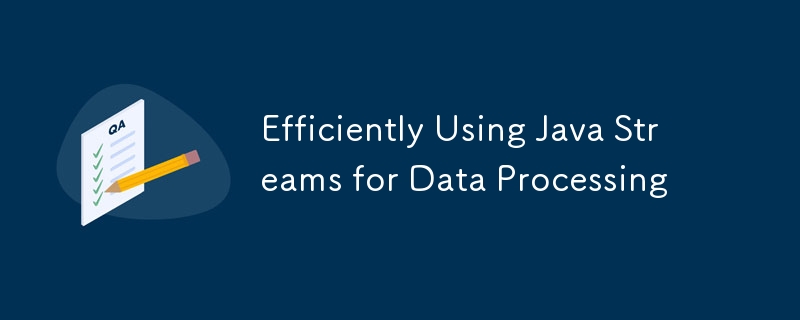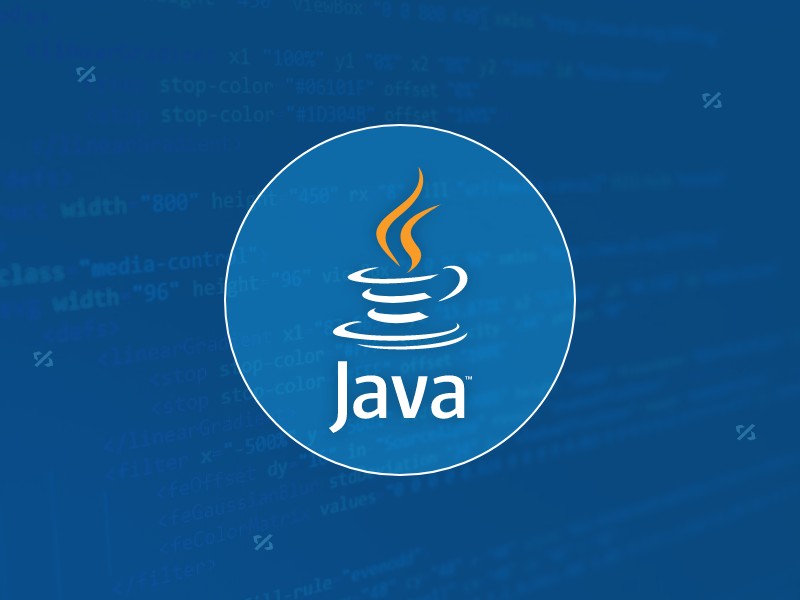Five points to pay attention to when using Java Streams: 1. Intermediate operations (such as filters, maps) must be executed through terminal operations (such as collect, forEach), otherwise it will not take effect; 2. Avoid modifying external variables in intermediate operations to prevent concurrency problems; 3. Select the terminal operation type according to the scene, such as anyMatch, which is more efficient to judge existence; 4. Parallel streams are suitable for complex operations in large data volumes, while small data increases overhead and is sensitive to sequence; 5. Reduce object creation and packing, and give priority to basic type streams such as IntStream to improve performance.

Java Streams is a powerful feature introduced in Java 8 to simplify the processing of collection data. Many people use it to write more concisely, but it still takes some skills and understanding to really use Streams efficiently.

Understand the difference between intermediate operations and terminal operations
Stream operations are divided into intermediate operations (such as filter , map ) and terminal operations (such as collect , forEach ). Intermediate operations will not be executed immediately, they are "lazy loading" and will only actually start processing data when encountering terminal operations.

This is crucial: if you only write a few intermediate operations but don't have terminal operations, then Stream actually does nothing. for example:
list.stream().filter(item -> item.isValid()); // No terminal operation will not be executed
suggestion:

- Intermediate operations can be called in chains, but in the end there must be a terminal operation.
- Avoid side effects (such as modifying external variables) in intermediate operations, which can easily cause concurrency problems.
Reasonably select the terminal operation type
Different terminal operations have different performance and applicable scenarios. For example:
-
collect(Collectors.toList())is suitable for collecting results; -
forEach()is suitable for traversal execution actions; -
reduce()is used for aggregation calculation; -
findFirst()andfindAny()have different behaviors in parallel streams.
A common misunderstanding is that when you only need to determine whether there are elements that meet the conditions, you mistakenly use filter().collect() and then check whether it is empty. The correct way is to use anyMatch() directly:
// Not recommended boolean found = list.stream().filter(item -> item.isValid()).collect(Collectors.toList()).size() > 0; // Recommend boolean found = list.stream().anyMatch(item -> item.isValid());
This will terminate the processing process in advance and improve efficiency.
Parallel flow is not a universal accelerator
Java provides parallelStream() to take advantage of multi-core advantages, but this does not mean that it is always faster. In fact, when using parallel streams is used in small data volumes or simple operations, it may actually cause additional overhead due to thread scheduling.
suggestion:
- When the data volume is large (such as more than tens of thousands) and the operation is complicated, parallelism will be considered.
- Sequence-sensitive operations (such as
findFirst()) may not achieve the expected results in parallel streams. - Pay attention to the synchronization of shared resources when using parallel streams.
For example, the following example:
int sum = numbers.parallelStream().mapToInt(Integer::intValue).sum();
If numbers are large, they can indeed increase the speed; but if there are only a few dozen elements, it is more appropriate to use a normal stream.
Try to avoid unnecessary object creation and boxing
The syntax of the Stream API is elegant, but you also need to pay attention to performance details. For example, frequent use of map() to create new objects will increase GC pressure. Also, it is best to use special Streams for processing basic types, such as IntStream and DoubleStream , rather than generic Streams.
For example:
// May cause packing overhead int sum = list.stream().mapToInt(Item::getValue).sum(); // Better int sum = IntStream.range(0, 100).sum();
Also, if you just traversal without returning values, you should give priority to normal loops, especially in hotspot code.
Basically that's it. Stream is very convenient, but to write clear and efficient code, you still have to make trade-offs based on the specific scenario.
The above is the detailed content of Efficiently Using Java Streams for Data Processing. For more information, please follow other related articles on the PHP Chinese website!

Hot AI Tools

Undress AI Tool
Undress images for free

Undresser.AI Undress
AI-powered app for creating realistic nude photos

AI Clothes Remover
Online AI tool for removing clothes from photos.

Clothoff.io
AI clothes remover

Video Face Swap
Swap faces in any video effortlessly with our completely free AI face swap tool!

Hot Article

Hot Tools

Notepad++7.3.1
Easy-to-use and free code editor

SublimeText3 Chinese version
Chinese version, very easy to use

Zend Studio 13.0.1
Powerful PHP integrated development environment

Dreamweaver CS6
Visual web development tools

SublimeText3 Mac version
God-level code editing software (SublimeText3)
 Asynchronous Programming Techniques in Modern Java
Jul 07, 2025 am 02:24 AM
Asynchronous Programming Techniques in Modern Java
Jul 07, 2025 am 02:24 AM
Java supports asynchronous programming including the use of CompletableFuture, responsive streams (such as ProjectReactor), and virtual threads in Java19. 1.CompletableFuture improves code readability and maintenance through chain calls, and supports task orchestration and exception handling; 2. ProjectReactor provides Mono and Flux types to implement responsive programming, with backpressure mechanism and rich operators; 3. Virtual threads reduce concurrency costs, are suitable for I/O-intensive tasks, and are lighter and easier to expand than traditional platform threads. Each method has applicable scenarios, and appropriate tools should be selected according to your needs and mixed models should be avoided to maintain simplicity
 Best Practices for Using Enums in Java
Jul 07, 2025 am 02:35 AM
Best Practices for Using Enums in Java
Jul 07, 2025 am 02:35 AM
In Java, enums are suitable for representing fixed constant sets. Best practices include: 1. Use enum to represent fixed state or options to improve type safety and readability; 2. Add properties and methods to enums to enhance flexibility, such as defining fields, constructors, helper methods, etc.; 3. Use EnumMap and EnumSet to improve performance and type safety because they are more efficient based on arrays; 4. Avoid abuse of enums, such as dynamic values, frequent changes or complex logic scenarios, which should be replaced by other methods. Correct use of enum can improve code quality and reduce errors, but you need to pay attention to its applicable boundaries.
 Understanding Java NIO and Its Advantages
Jul 08, 2025 am 02:55 AM
Understanding Java NIO and Its Advantages
Jul 08, 2025 am 02:55 AM
JavaNIO is a new IOAPI introduced by Java 1.4. 1) is aimed at buffers and channels, 2) contains Buffer, Channel and Selector core components, 3) supports non-blocking mode, and 4) handles concurrent connections more efficiently than traditional IO. Its advantages are reflected in: 1) Non-blocking IO reduces thread overhead, 2) Buffer improves data transmission efficiency, 3) Selector realizes multiplexing, and 4) Memory mapping speeds up file reading and writing. Note when using: 1) The flip/clear operation of the Buffer is easy to be confused, 2) Incomplete data needs to be processed manually without blocking, 3) Selector registration must be canceled in time, 4) NIO is not suitable for all scenarios.
 How does a HashMap work internally in Java?
Jul 15, 2025 am 03:10 AM
How does a HashMap work internally in Java?
Jul 15, 2025 am 03:10 AM
HashMap implements key-value pair storage through hash tables in Java, and its core lies in quickly positioning data locations. 1. First use the hashCode() method of the key to generate a hash value and convert it into an array index through bit operations; 2. Different objects may generate the same hash value, resulting in conflicts. At this time, the node is mounted in the form of a linked list. After JDK8, the linked list is too long (default length 8) and it will be converted to a red and black tree to improve efficiency; 3. When using a custom class as a key, the equals() and hashCode() methods must be rewritten; 4. HashMap dynamically expands capacity. When the number of elements exceeds the capacity and multiplies by the load factor (default 0.75), expand and rehash; 5. HashMap is not thread-safe, and Concu should be used in multithreaded
 Effective Use of Java Enums and Best Practices
Jul 07, 2025 am 02:43 AM
Effective Use of Java Enums and Best Practices
Jul 07, 2025 am 02:43 AM
Java enumerations not only represent constants, but can also encapsulate behavior, carry data, and implement interfaces. 1. Enumeration is a class used to define fixed instances, such as week and state, which is safer than strings or integers; 2. It can carry data and methods, such as passing values ??through constructors and providing access methods; 3. It can use switch to handle different logics, with clear structure; 4. It can implement interfaces or abstract methods to make differentiated behaviors of different enumeration values; 5. Pay attention to avoid abuse, hard-code comparison, dependence on ordinal values, and reasonably naming and serialization.
 What is a Singleton design pattern in Java?
Jul 09, 2025 am 01:32 AM
What is a Singleton design pattern in Java?
Jul 09, 2025 am 01:32 AM
Singleton design pattern in Java ensures that a class has only one instance and provides a global access point through private constructors and static methods, which is suitable for controlling access to shared resources. Implementation methods include: 1. Lazy loading, that is, the instance is created only when the first request is requested, which is suitable for situations where resource consumption is high and not necessarily required; 2. Thread-safe processing, ensuring that only one instance is created in a multi-threaded environment through synchronization methods or double check locking, and reducing performance impact; 3. Hungry loading, which directly initializes the instance during class loading, is suitable for lightweight objects or scenarios that can be initialized in advance; 4. Enumeration implementation, using Java enumeration to naturally support serialization, thread safety and prevent reflective attacks, is a recommended concise and reliable method. Different implementation methods can be selected according to specific needs
 Java Optional example
Jul 12, 2025 am 02:55 AM
Java Optional example
Jul 12, 2025 am 02:55 AM
Optional can clearly express intentions and reduce code noise for null judgments. 1. Optional.ofNullable is a common way to deal with null objects. For example, when taking values ??from maps, orElse can be used to provide default values, so that the logic is clearer and concise; 2. Use chain calls maps to achieve nested values ??to safely avoid NPE, and automatically terminate if any link is null and return the default value; 3. Filter can be used for conditional filtering, and subsequent operations will continue to be performed only if the conditions are met, otherwise it will jump directly to orElse, which is suitable for lightweight business judgment; 4. It is not recommended to overuse Optional, such as basic types or simple logic, which will increase complexity, and some scenarios will directly return to nu.
 How to fix java.io.NotSerializableException?
Jul 12, 2025 am 03:07 AM
How to fix java.io.NotSerializableException?
Jul 12, 2025 am 03:07 AM
The core workaround for encountering java.io.NotSerializableException is to ensure that all classes that need to be serialized implement the Serializable interface and check the serialization support of nested objects. 1. Add implementsSerializable to the main class; 2. Ensure that the corresponding classes of custom fields in the class also implement Serializable; 3. Use transient to mark fields that do not need to be serialized; 4. Check the non-serialized types in collections or nested objects; 5. Check which class does not implement the interface; 6. Consider replacement design for classes that cannot be modified, such as saving key data or using serializable intermediate structures; 7. Consider modifying






